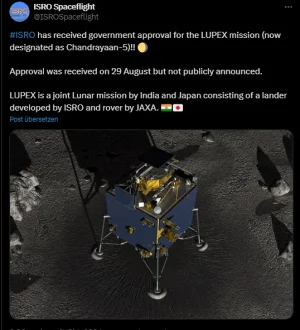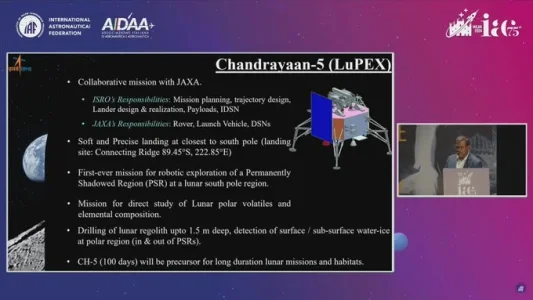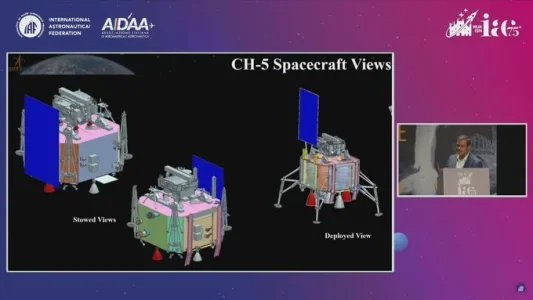- Joined
- Jun 30, 2024
- Messages
- 2,995
- Likes
- 26,196






Very ambitious, sub-surface samples will be collected from 2m depthWe are targetting direct south pole in CY-4 mission
View attachment 12553
Since it will collect both surface & sub-surface samples, there may be chances of bringing back samples with lunar ice
CY-4 mission profile
View attachment 12555
CY-5 aka LUPEX
View attachment 12556
View attachment 12557
@Indx TechStyle @swesh @FalconSlayers


India plans to launch the Chandrayaan-4 moon sample-return mission in 2028 before sending an uncrewed lander and rover in collaboration with Japan, revealed S Somanath, the chairman of the Indian Space Research Organisation (ISRO), during a talk session in New Delhi last week.
The latest mission aims to collect 6.6 pounds (3 kilograms) of lunar samples from a water-ice-rich area close to the south pole of the moon and then deliver the samples to Earth. The Indian government has already approved the mission which is likely to boost its space economy. This Chandrayaan 4 mission was allocated 21 billion rupees ($250 million US).
S. Somanath, shedding light on Isro's upcoming mission, said that the US and Russia have done it in the past, but doing it today is still a huge challenge, and expensive. "We are looking at how we can do a mission to the moon and back in a low-cost manner," he added.
The architecture of the mission includes five spacecraft modules requiring two launches from Isro's most powerful rocket, the LVM-3. The first of the two launches is the transportation of a lander and sample-collecting vehicle and the second one will take a transfer module and a reentry module that will be parked in lunar orbit.
Then the ascender carrying the collected samples will launch from the moon's surface and transfer that precious cargo to the reentry module that is heading to earth for a safe touchdown.
According to the Deccan Herald report, the most challenging task for the Chandrayaan-4 mission is to practise in-orbiting two spacecraft. Later this year or early 2025, Isro will launch a $14 million space docking experience called, Spadex.
Isro has also developed some homegrown technologies which are being developed for the moon mission including a robotic arm to scoop from the lunar surface and a drilling mechanism to collect samples a few metres below the surface.
The landing region is yet to be announced. According to some previous reports, the mission would aim to land near Shakti Point near the moon's south pole, the same place where India's Chandrayaan-3 spacecraft landed.
The South Pole region is the first choice as it has an abundance of water ice. Scientists suspect that the ice can be mined for life support and rocket fuel.
Nasa also shortlisted nine landing sites near the lunar south pole for its first crewed moon landing, Artemis 3. China is also targeting the south pole aiming to put astronauts on the moon before the end of the decade.
While for the Chandrayaan-5 mission, also known as the Lunar Polar Exploration Project, or LUPEX, there will be a joint project between Isro and Japan's JAXA, involving a 770-pound (350 kg) rover. Somnath said that Lupex will be a dozen times heavier than the 60-pound (27 kg) Pragyan that flew on Chandrayaan-3.
India will provide the lander, mission planning and payloads, while Japan will contribute the launch vehicle, various payloads and the rover. Both sides will contribute to ground penetrating radar, a range of spectrometers and water analysis instruments.
India aims to land astronauts on the moon by 2040 and will establish a moon base before 2050.
For now, "all of us are excited to design and develop this complex mission [Chandrayaan-4] and make it happen by 2028," Somanath added.
India eyeing 2028 deadline for Chandrayaan-4 sample-return mission to Moon
The South Pole region is the first choice for the landing of Chandrayaan-4 as it has an abundance of water ice. Scientists suspect that the ice can be mined for life support and rocket fuel.

New Delhi: ISRO Chairman S. Somanath delivers the Sardar Vallabhbhai Patel Memorial Lecture 2024, in New Delhi, Saturday, Oct. 26, 2024. (Photo: PTI)
Isro to launch practice mission
Landing site is yet to be determined
India-Japan joint mission
In case of LUPEX (Chandrayaan-5), Japan would be providing the heavy rover and launcher (India doesn't have a rocket powerful as H-III). India will just provide lander. LUPEX essentially is just a Japanese mission using Indian landing technology.I thought ISRO was the one that was gonna launch the probes and provide the lander while Japan would provide satellites and rover etc.
Its not a Japanese mission using Indian lander, this mission includes science payloads from our side as well, it's a joint mission, an Indo-Japanese mission.In case of LUPEX (Chandrayaan-5), Japan would be providing the heavy rover and launcher (India doesn't have a rocket powerful as H-III). India will just provide lander. LUPEX essentially is just a Japanese mission using Indian landing technology.
They will learn & get lander tech and we would learn to make RTEG based heavy rovers for Chandrayaan-6 & 7 (it seems like that kind of tech exchange only hopefully).
They wouldneither will CY-6 & 7
Sauce?They would
Heard somewhere in a speech by Somanath that RTEG in development will be the basis of upcoming long duration Indian deep space missions.Sauce?




